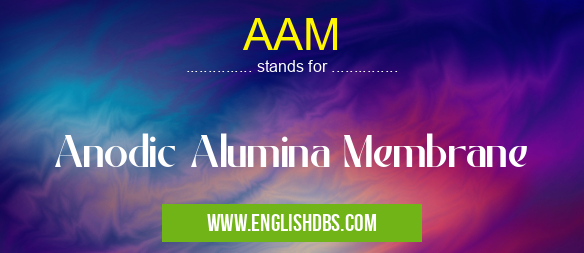What does AAM mean in UNCLASSIFIED
Anodic Alumina Membrane (AAM) is a porous material made from anodized aluminum. It is widely used in various applications, such as filtration, separation, and catalysis.

AAM meaning in Unclassified in Miscellaneous
AAM mostly used in an acronym Unclassified in Category Miscellaneous that means Anodic Alumina Membrane
Shorthand: AAM,
Full Form: Anodic Alumina Membrane
For more information of "Anodic Alumina Membrane", see the section below.
### What is AAM?
AAM is a thin, self-ordered, and highly porous oxide layer formed on the surface of aluminum metal by electrochemical anodization. The anodization process involves immersing the aluminum in an electrolyte solution and applying a voltage. This process leads to the formation of a porous alumina layer with a uniform pore size and a high aspect ratio.
### Properties of AAM:
- High porosity: AAM membranes have a porosity of up to 95%, allowing for high flow rates.
- Uniform pore size: The pores in AAM membranes are highly uniform in size and shape, providing precise control over filtration and separation.
- Chemical stability: AAM is chemically inert and resistant to harsh chemicals, making it suitable for a wide range of applications.
- Mechanical strength: AAM is a mechanically strong material, making it durable and resistant to deformation.
### Applications of AAM:
AAM is used in various applications, including:
- Filtration: AAM membranes are used in water purification, wastewater treatment, and gas filtration.
- Separation: AAM membranes can be used to separate particles, molecules, and ions based on their size and charge.
- Catalysis: AAM membranes can be coated with catalytic materials, making them useful for reactions like water splitting and hydrogen production.
- Sensors: AAM membranes can be integrated with sensors to detect ions, molecules, and biomolecules.
Essential Questions and Answers on Anodic Alumina Membrane in "MISCELLANEOUS»UNFILED"
What is Anodic Alumina Membrane (AAM)?
Anodic Alumina Membrane (AAM) is a highly ordered, nanoporous material with a uniform pore structure. It is fabricated through a process called anodic oxidation of aluminum, where a thin aluminum foil is anodized in an acidic electrolyte. This process results in the formation of a porous alumina layer on the aluminum surface.
What are the key properties of AAM?
AAM possesses unique properties, including:
- High aspect ratio and uniform pores
- Narrow pore size distribution
- Tunable pore diameter and length
- Excellent chemical and thermal stability
- High surface area and porosity
What are the applications of AAM?
AAM has a wide range of applications in various fields, such as:
- Water filtration and purification
- Biomedical devices
- Energy storage and conversion
- Optical devices
- Sensors and electronics
How is AAM characterized?
The characterization of AAM typically involves techniques such as:
- Scanning electron microscopy (SEM) for pore morphology analysis
- Nitrogen adsorption-desorption for surface area and pore size measurements
- X-ray diffraction (XRD) for crystal structure determination
- Electrochemical impedance spectroscopy for ionic conductivity assessment
What are the advantages of AAM over other nanoporous materials?
AAM offers several advantages over other nanoporous materials, including:
- Its high aspect ratio and uniform pores provide exceptional transport properties.
- Its chemical stability allows it to withstand harsh environments.
- Its tunable pore structure enables tailoring of properties for specific applications.
- Its relatively low cost and scalability make it a promising material for industrial applications.
Final Words: AAM is a versatile material with unique properties that make it valuable for applications in filtration, separation, catalysis, and sensing. Its high porosity, uniform pore size, chemical stability, and mechanical strength make it an ideal choice for a wide range of industrial and scientific applications.
AAM also stands for: |
|
| All stands for AAM |
